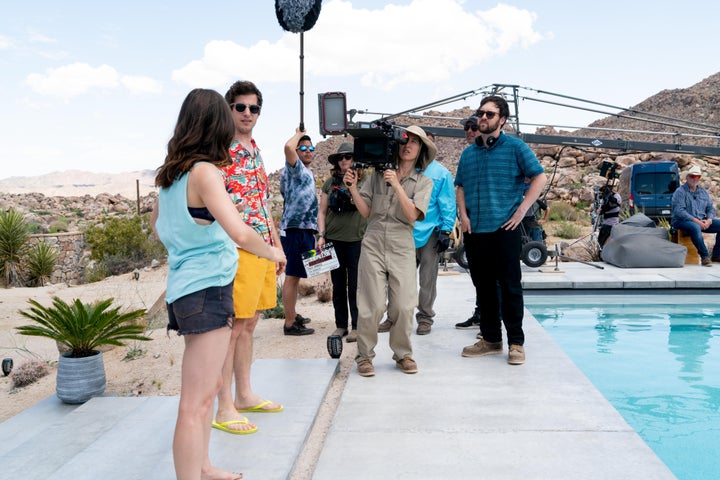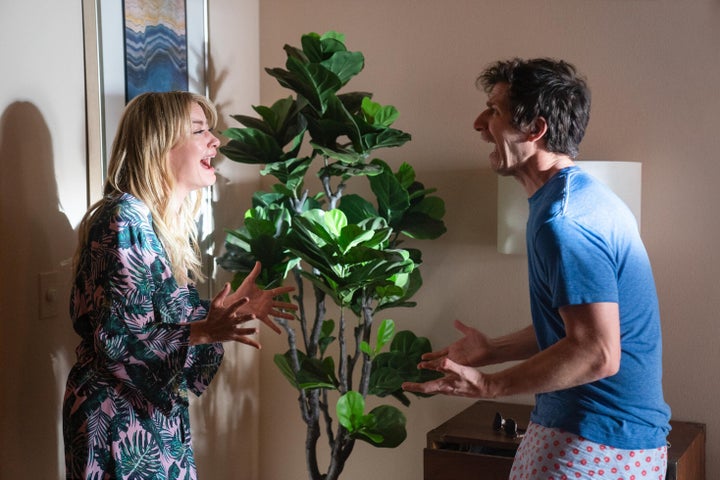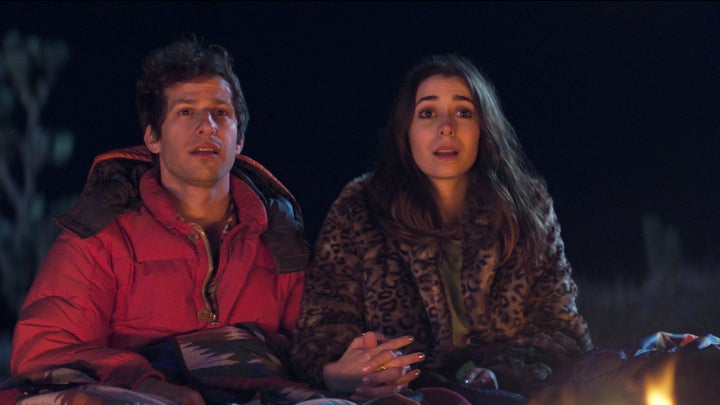“Palm Springs” is 2020’s biggest and brightest comedy movie.
Back in January, it set a record at Sundance, becoming the priciest acquisition in the festival’s 42-year history. Hulu partnered with the independent theatrical distributor Neon (the company behind “Parasite” and “I, Tonya”) to pay $17,500,000.69 for the rights. That cheeky 69 cents is what outpaced the previous record-holder, 2016’s beleaguered “The Birth of a Nation.”
Dropping such a hefty sum on one movie is always a gamble, but this one appears to have paid off. “Palm Springs” couldn’t open in traditional theaters due to the COVID-19 pandemic, but the serendipitous Hulu arrangement allowed the Andy Samberg vehicle to premiere digitally on July 10 at a moment when people desperately needed a smart, stylish summer comedy. In an email sent to press on Tuesday, the service announced that it was the “most-watched film ever on Hulu during its opening weekend.”
There’s another reason “Palm Springs” feels like a small miracle: Old-school Hollywood studios have all but abandoned comedies like this. Original scripts with sophisticated concepts and A-list casts used to have blockbuster potential, but in an era monopolized by big-budget franchises, the wide-release comedy has been deemed expendable. With notable exceptions — “Knives Out,” for example, or “Crazy Rich Asians,” though technically that’s based on existing material — streamers like Hulu, Netflix and Amazon Prime have become repositories for the genres that no longer interest I.P.-obsessed executives. Too bad most of those offerings aren’t as good as “Palm Springs.”
The movie is the brainchild of director Max Barbakow and screenwriter Andy Siara, California natives who met when they were students at the American Film Institute. Wanting to make a feature together, Barbakow and Siara took a trip to the desert town of Palm Springs in 2015 to brainstorm ideas. There, they developed Nyles, a commitment-phobic goober with a melancholy energy whom Samberg would come to portray.
“Over the next couple of years, we just talked nonstop about who this character is and then started putting him in scenarios to challenge his worldview,” Siara said. After the celebrated British sitcoms “Fleabag” and “Catastrophe” premiered, Barbakow and Siara saw the shows as models for how to blend playful comedy and philosophical drama.

Around the same time, the men were doing what many people do in their late 20s: attending lots of friends’ weddings. Siara, in fact, got married in Palm Springs, at which point Barbakow was feeling the sting of being single and nowhere near achieving that milestone. In discussing those insecurities, Barbakow and Siara landed on a premise: What if Nyles woke up every day at the same November 9 wedding, surrounded by others’ interminable joy, unable to leave? It was a millennial riff on the time-loop hit “Groundhog Day,” the exact sort of comedy that Hollywood once devoured.
“Groundhog Day” ends with its cynical protagonist (Bill Murray) escaping his temporal prison by becoming a better person. He falls in love and learns that good deeds provide a pathway to fulfillment. Nyles, on the other hand, doesn’t have the same luck.
“Let’s say he’s stuck in a time loop and he figures out the meaning of life or what he thinks the meaning of life is, and the day does not end. It just starts right back over,” Siara said. “Then what do you do? You have to learn to exist in the meaninglessness of it all and find peace in it. And so he finds peace in burritos, beers and floating in the pool. That became this jumping-off point where we looked at this kind of like a sequel to a movie that doesn’t exist.”
Indeed, “Palm Springs” wisely begins with the time loop already intact, though the audience doesn’t know it yet, unless they’ve seen the trailer or read this article. Nyles has been floating in that pool and attending that Pinterest-made wedding with his dopey, philandering girlfriend (Meredith Hagner) for God knows how long. He’d arrived at his dilemma by crawling through a mystical cave with a gleaming orange orb that Barbakow likened to the famous “Pulp Fiction” briefcase, which emits a similar light beam.

Using that conceit, Barbakow and Siara just needed to puzzle out how Nyles can finally flee his predicament before growing too hopeless. A question he might ask himself is one that many of us are wondering amid the COVID-19 pandemic’s social-distancing strictures: What is life worth if it’s shrouded in monotony? (And furthermore, what is marriage if not a pledge to monotony?) They had to concoct a plot device that would yield the enlightenment Nyles needed so he could find liberation.
That’s where Sarah (Cristin Milioti) came in. Perpetually drunk and mildly enraged, Sarah is the sister of the bride. She risks bungling the maid-of-honor speech she hasn’t properly prepared, and Nyles swoops in to save her from humiliation. Siara opted to establish the pairing’s meet-cute within the movie’s first 12 minutes, letting the exposition unfold like an ordinary romantic comedy. If you don’t already know the twist, you’d think Nyles was just a good-looking depressed guy with a decent sense of humor, waiting for some manic pixie dream girl to rouse his spirit. But then Roy (J.K. Simmons) enters, and Siara and Barabow really flex their creative muscles.
“Roy was the final piece of the puzzle in figuring out this story,” Siara explained. “There were other drafts that did not have Roy, and I remember the conversation I had with Max. We knew it was missing some other piece of this puzzle. And I think it actually is perhaps one of the more important thematic pieces of the puzzle.”
Roy became the person who actually sets the film in motion, showing up out of nowhere wielding a bow and arrow while Nyles and Sarah are making out on a rock formation near the cave. Sarah still doesn’t know Nyles is stuck in a time loop when he takes off running, jolting her into panicked fish-out-of-water mode. Barbakow and Siara determined that Roy had followed Nyles into the cave, only to resent him for it later. Taking inspiration from “Raising Arizona,” Roy became their “slapstick” version of the apocalyptic biker haunting Nicolas Cage’s dreams. “There needed to be a ticking clock or some sort of urgency to this,” Barbakow said.

In order to give Nyles a partner with whom he can test-drive new escapes, they had Sarah wander into the cave, too, even as Nyles warned her not to. When Sarah wakes up the next day, she’s right back where she started, expected to deliver her sister’s wedding toast for the rest of eternity. But she is not merely a tool for Nyles’ self-discovery. She is a fully developed character with her own existential hangups, and Milioti winds up stealing the movie from her more famous co-star.
“Sarah came along as a means for us to get into the story and explore Nyles’ predicament as this emotional catalyst, and she ends up exploring a similar set of issues in her own way, too,” Barbakow said. “So it became a two-hander.”
Nyles and Sarah’s journey to freedom took many forms. When Barbakow and Siara first met with Samberg about doing the movie, the script had a different ending. It was Samberg — who also signed on as a producer alongside his longtime pals Akiva Schaffer and Jorma Taccone, collectively known as the Lonely Island — who suggested Nyles and Sarah blow up the cave.
Siara went down a “YouTube spiral” researching quantum theory, leading to a wordy monologue in which Sarah explained in detail how they’d pull it all off. ”I kind of rationalized a way for it to make sense,” he said. (The production also sought advice from physicist Clifford Johnson, who has provided counsel on “Avengers: Endgame” and “Star Trek: Discovery.”) Sarah’s speech got left on the cutting-room floor, but its ideas remain intact: They will attempt to detonate the cave at the exact moment the universe would normally reset them back to the day’s beginning.
All the while, Nyles and Sarah — much like Bill Murray and Andie MacDowell at the close of “Groundhog Day” — are divining whether they’re actually meant to be together if they return to regular existence. Nyles has to take a leap of faith to go along with Sarah’s plan. “I hope that blowing ourselves up works,” he says. “But it’s really irrelevant to me as long as I’m with you. And if it kills us, well, then I’d rather die with you than live in this world without you.”

“We made Cristin get her Ph.D. in quantum physics the night before by memorizing all these different terms and then just cut it out of the movie,” Barbakow said, chuckling. “Because hopefully at that point you’re just invested in what’s going on beneath it, the subtext of that moment, which is, like, will-they-won’t-they. Will he pull his head out of his ass? Will she take him back?”
Nyles and Sarah’s scheme works. When they next wake, it is no longer November 9. In a short scene during the end credits, we realize that Roy has escaped, too, which makes sense because all three characters have matured in the process. Nyles learns to invest in other people, Sarah learns not to resist the potential tedium of long-term companionship, and Roy learns to let go of his resentments about the cards that life has dealt him. When Nyles tracks down Roy at his home right before the movie’s finale, we get a distillation of everything Barbakow and Siara hoped to say in “Palm Springs.”
“That scene by the pool is one of the few scenes where really not much changed [in the script], because that kind of hammers in the theme of our movie,” Siara said. “When Roy says, ‘at least we don’t have to go through this shit alone,’ it’s kind of looking at life in a bittersweet way. He just learns to find the beauty in the mundane.”
Calling all HuffPost superfans!
Sign up for membership to become a founding member and help shape HuffPost’s next chapter
Credit: Source link